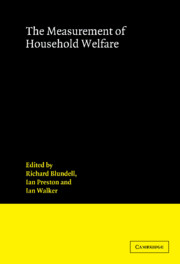Book contents
- Frontmatter
- Contents
- List of contributors
- 1 An introduction to applied welfare analysis
- 2 Measuring the cost of children: a theoretical framework
- 3 The collective approach to household behaviour
- 4 Ordinal and cardinal utility: an integration of the two dimensions of the welfare concept
- 5 The determination of welfare in nonintact families
- 6 Female labour supply, housework and family welfare
- 7 Engel equivalence scales in Sri Lanka: exactness, specification, measurement error
- 8 Measuring the life-cycle consumption costs of children
- 9 Family fortunes in the 1970s and 1980s
- 10 Ethically-consistent welfare prescriptions are reference price-independent
- 11 The effect of systematic misperception of income on the subjective poverty line
- Index of names
- Index of subjects
11 - The effect of systematic misperception of income on the subjective poverty line
Published online by Cambridge University Press: 13 January 2010
- Frontmatter
- Contents
- List of contributors
- 1 An introduction to applied welfare analysis
- 2 Measuring the cost of children: a theoretical framework
- 3 The collective approach to household behaviour
- 4 Ordinal and cardinal utility: an integration of the two dimensions of the welfare concept
- 5 The determination of welfare in nonintact families
- 6 Female labour supply, housework and family welfare
- 7 Engel equivalence scales in Sri Lanka: exactness, specification, measurement error
- 8 Measuring the life-cycle consumption costs of children
- 9 Family fortunes in the 1970s and 1980s
- 10 Ethically-consistent welfare prescriptions are reference price-independent
- 11 The effect of systematic misperception of income on the subjective poverty line
- Index of names
- Index of subjects
Summary
Introduction
Empirical evidence indicates that respondents misperceive their own household after-tax income (see Kapteyn et al., 1988); respondents appear to underestimate their household after-tax income. As will be explained below, this underestimation turns out to have a downward-biasing effect on the subjective poverty line in empirical implementation. Walker (1987) also pointed out that the concept of income the respondent has in mind may not always be the same as the researcher's. In Kapteyn et al. (1988) a method is presented to remedy this bias. One can adjust the responses to subjective questions if these questions are preceded by a question which measures the respondent's perception of his household after-tax income. The misperception of income can be calculated from a comparison of the respondent's perception of the income with the measurement of income as the sum of a lengthy list of components. Next the responses to the subjective questions can be corrected. An alternative is of course to avoid the misperception, by prefacing the subjective questions with the detailed questions about household income components. Here, the focus is on the former case.
Kapteyn et al. (1988) assume that the answers to the subjective questions are biased in the same proportion as income is underestimated by the respondent. In this chapter, this assumption is tested within the context of the so-called Subjective Poverty Line (SPL) (see Goedhart et al., 1977). The second section concisely introduces the SPL concept.
- Type
- Chapter
- Information
- The Measurement of Household Welfare , pp. 265 - 274Publisher: Cambridge University PressPrint publication year: 1994
- 2
- Cited by



